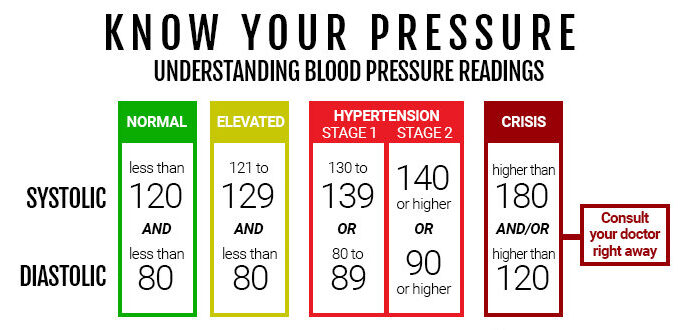How To Read And Understand Blood Pressure Measurements?

Blood pressure is a vital physiological parameter that reflects the force exerted by blood against the walls of arteries during circulation. It is measured using a sphygmomanometer and expressed as two values: systolic pressure over diastolic pressure.
Understanding these measurements is crucial as they provide insights into cardiovascular health and can help detect underlying conditions such as hypertension or hypotension.
This article aims to provide a comprehensive understanding of blood pressure readings, focusing on the interpretation of systolic and diastolic pressures, the ideal blood pressure range, and factors that influence these measurements.
Additionally, the article will discuss the importance of monitoring blood pressure regularly and provide tips for maintaining healthy levels. It will also address instances where medical attention should be sought for high or low blood pressure.
By enhancing readers’ knowledge of blood pressure measurements, this article aims to promote informed decision-making and proactive management of cardiovascular health.
Key Takeaways
- Blood pressure measurements consist of two numbers: systolic pressure (the higher number) and diastolic pressure (the lower number).
- A healthy blood pressure reading is typically around 120/80 mm Hg or lower.
- High blood pressure can lead to serious health complications such as heart disease, stroke, and kidney problems.
- Low blood pressure can be a symptom of underlying medical conditions and may cause symptoms such as dizziness, fainting, and fatigue.
What is Blood Pressure and How is it Measured?
Blood pressure is a physiological measurement that quantifies the force exerted by circulating blood on the walls of blood vessels. It is typically measured using a sphygmomanometer, which consists of an inflatable cuff and a pressure gauge.
Blood pressure measurement techniques involve wrapping the cuff around the upper arm and inflating it to temporarily stop blood flow. As the cuff is slowly deflated, the pressure is released, and the healthcare provider listens for the sounds of blood flow using a stethoscope.
The systolic pressure, representing the force when the heart contracts, and the diastolic pressure, indicating the force when the heart is at rest, are recorded.
Several factors can affect blood pressure accuracy, including cuff size, arm position, and patient-related factors such as anxiety or caffeine consumption. Ensuring proper technique and addressing these factors is crucial for obtaining accurate blood pressure measurements.
Understanding Systolic and Diastolic Pressure
Systolic and diastolic pressure are essential components of blood pressure measurements, providing valuable information about the contraction and relaxation phases of the heart. Understanding these two measurements is crucial in assessing a person’s overall cardiovascular health.
Here are three key points to help you understand systolic and diastolic pressure:
- Systolic pressure range: This represents the maximum pressure exerted on the arterial walls during the contraction of the heart. It is the top number in a blood pressure reading and is considered normal when it falls below 120 mmHg.
- Diastolic pressure range: This represents the minimum pressure on the arterial walls when the heart is at rest between beats. It is the bottom number in a blood pressure reading and is considered normal when it falls below 80 mmHg.
By understanding the systolic and diastolic pressure ranges, individuals can monitor their blood pressure readings and take necessary steps to maintain a healthy cardiovascular system.
The Ideal Blood Pressure Range
The optimal range for healthy blood pressure is characterized by a harmonious balance between the forceful contraction and the restful relaxation of the heart. Blood pressure guidelines provide a reference for normal blood pressure levels. The ideal blood pressure range is typically defined as a systolic pressure of less than 120 mmHg and a diastolic pressure of less than 80 mmHg. This range is considered normal and indicates a healthy cardiovascular system. However, it is important to note that individual variations may exist, and certain factors such as age, gender, and overall health can influence what is considered ideal for each person. Monitoring blood pressure regularly and consulting with a healthcare professional can help determine an individual’s ideal blood pressure range and ensure optimal cardiovascular health.
| Blood Pressure Classification | Systolic Pressure (mmHg) | Diastolic Pressure (mmHg) |
|---|---|---|
| Normal | Less than 120 | Less than 80 |
| Elevated | 120-129 | Less than 80 |
| Hypertension Stage 1 | 130-139 | 80-89 |
| Hypertension Stage 2 | 140 or higher | 90 or higher |
| Hypertensive Crisis | Higher than 180 | Higher than 120 |
Factors that Affect Blood Pressure
Factors such as age, gender, and overall health can influence an individual’s blood pressure readings, providing valuable insights into their cardiovascular well-being. Understanding these factors is important in interpreting blood pressure measurements accurately.
Here are some key considerations:
- Lifestyle choices: Unhealthy habits such as smoking, excessive alcohol consumption, and a sedentary lifestyle can increase blood pressure. Conversely, regular exercise, a balanced diet, and stress management can help maintain healthy blood pressure levels.
- Medication effects: Certain medications, such as nonsteroidal anti-inflammatory drugs (NSAIDs), decongestants, and hormonal contraceptives, can elevate blood pressure. It is important to be aware of the potential effects of any medications being taken and discuss with a healthcare professional if there are concerns about blood pressure changes.
- Age: Blood pressure tends to increase with age due to the natural aging process and changes in blood vessel elasticity. Regular blood pressure monitoring is particularly important for older individuals.
- Gender: Men generally have a higher risk of developing high blood pressure compared to women, especially before menopause. However, after menopause, the risk for women increases.
By considering these factors, healthcare professionals can better assess an individual’s blood pressure readings and provide appropriate recommendations for maintaining cardiovascular health.
Interpreting Blood Pressure Readings
Interpreting blood pressure readings requires careful consideration of various indicators related to an individual’s cardiovascular well-being. Understanding blood pressure values is crucial in determining the presence of hypertension, a major risk factor for cardiovascular diseases. Blood pressure is measured in millimeters of mercury (mmHg) and is expressed as a ratio of systolic pressure (the top number) over diastolic pressure (the bottom number). The American Heart Association classifies blood pressure into different categories, ranging from normal to hypertensive crisis. Table 1 provides a summary of these categories and their corresponding blood pressure values. It is essential to note that blood pressure readings can vary throughout the day, influenced by factors such as stress, physical activity, and medication. Therefore, regular monitoring and interpretation of blood pressure measurements are vital in assessing an individual’s cardiovascular health.
| Blood Pressure Category | Systolic (mmHg) | Diastolic (mmHg) |
|---|---|---|
| Normal | <120 | <80 |
| Elevated | 120-129 | <80 |
| Hypertension Stage 1 | 130-139 | 80-89 |
| Hypertension Stage 2 | ≥140 | ≥90 |
| Hypertensive Crisis | >180 | >120 |
The Importance of Monitoring Blood Pressure
Regular check-ups to monitor blood pressure are crucial due to the potential long-term effects of high blood pressure. Keeping track of blood pressure readings allows individuals to assess their cardiovascular health and take appropriate measures to prevent complications. Regular monitoring enables healthcare professionals to detect any changes in blood pressure patterns and adjust treatment plans accordingly. Moreover, it helps individuals to understand the significance of maintaining a healthy lifestyle and adhering to medication regimens.
The importance of regular check-ups cannot be overstated, as high blood pressure, if left uncontrolled, can lead to serious health problems such as heart disease, stroke, and kidney disease. By regularly monitoring blood pressure, individuals can identify any fluctuations or increases in readings, enabling timely intervention and prevention of potential complications.
To emphasize the significance of regular blood pressure check-ups, consider the following points:
- It allows for early detection and intervention, reducing the risk of long-term complications.
- It facilitates the assessment of treatment effectiveness and the need for adjustments.
- It empowers individuals to take control of their health by making informed decisions based on blood pressure readings.
Tips for Maintaining Healthy Blood Pressure Levels
Implementing lifestyle changes such as consuming a balanced diet rich in fruits, vegetables, and whole grains, engaging in regular physical activity, and reducing sodium intake can contribute to maintaining healthy blood pressure levels. Dietary recommendations for individuals aiming to maintain healthy blood pressure levels include reducing the intake of foods high in saturated and trans fats, cholesterol, and added sugars. Instead, emphasis should be placed on consuming foods low in sodium, fat, and cholesterol. Exercise recommendations include engaging in moderate aerobic exercise for at least 150 minutes per week or vigorous aerobic exercise for 75 minutes per week, along with muscle-strengthening activities at least twice a week. These lifestyle modifications can effectively lower blood pressure and reduce the risk of hypertension-related complications.
| Dietary Recommendations | Exercise Recommendations |
|---|---|
| Consume a balanced diet rich in fruits, vegetables, and whole grains | Engage in moderate aerobic exercise for at least 150 minutes per week or vigorous aerobic exercise for 75 minutes per week |
| Reduce intake of foods high in saturated and trans fats, cholesterol, and added sugars | Include muscle-strengthening activities at least twice a week |
| Limit sodium intake |
When to Seek Medical Attention for High or Low Blood Pressure
Seeking timely medical attention is crucial when experiencing extreme fluctuations in blood pressure levels, as it can help identify and address any underlying health conditions contributing to high or low blood pressure.
High blood pressure, also known as hypertension, can lead to serious medical conditions such as heart disease, stroke, and kidney problems. If you consistently have blood pressure readings above 180/120 mm Hg, it is considered a hypertensive crisis and immediate medical attention is required.
On the other hand, low blood pressure, or hypotension, can be a symptom of an underlying medical condition such as dehydration, heart problems, or endocrine disorders. If you frequently experience symptoms such as dizziness, fainting, or fatigue accompanied by low blood pressure readings, it is important to seek medical attention to determine the cause and make necessary lifestyle changes or medical interventions to stabilize your blood pressure.
Frequently Asked Questions
What are the potential long-term effects of high blood pressure?
The long-term consequences of high blood pressure, or hypertension, can include an increased risk of cardiovascular diseases such as heart attacks and strokes, as well as damage to organs such as the heart, kidneys, and eyes.
Can stress and anxiety affect blood pressure readings?
Stress and anxiety can indeed affect blood pressure readings. Chronic stress can lead to elevated blood pressure levels, while managing stress through relaxation techniques and lifestyle changes can contribute to healthier blood pressure.
Is it normal for blood pressure to fluctuate throughout the day?
Blood pressure fluctuations throughout the day are normal due to the body’s blood pressure regulation mechanisms. Various factors can influence blood pressure, including physical activity, stress levels, diet, medication, and time of day.
Are there any natural remedies or lifestyle changes that can help lower blood pressure?
Natural remedies and lifestyle changes can help lower blood pressure. Strategies such as maintaining a healthy weight, exercising regularly, reducing salt intake, and managing stress have been shown to be effective in lowering blood pressure levels.
Can certain medications or medical conditions cause temporary spikes in blood pressure?
Medications and certain medical conditions can cause temporary spikes in blood pressure. Medication side effects, such as stimulants and decongestants, can increase blood pressure. Underlying medical conditions, like kidney disease or hormonal disorders, can also lead to elevated blood pressure levels.









